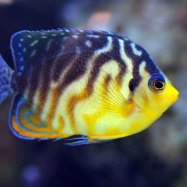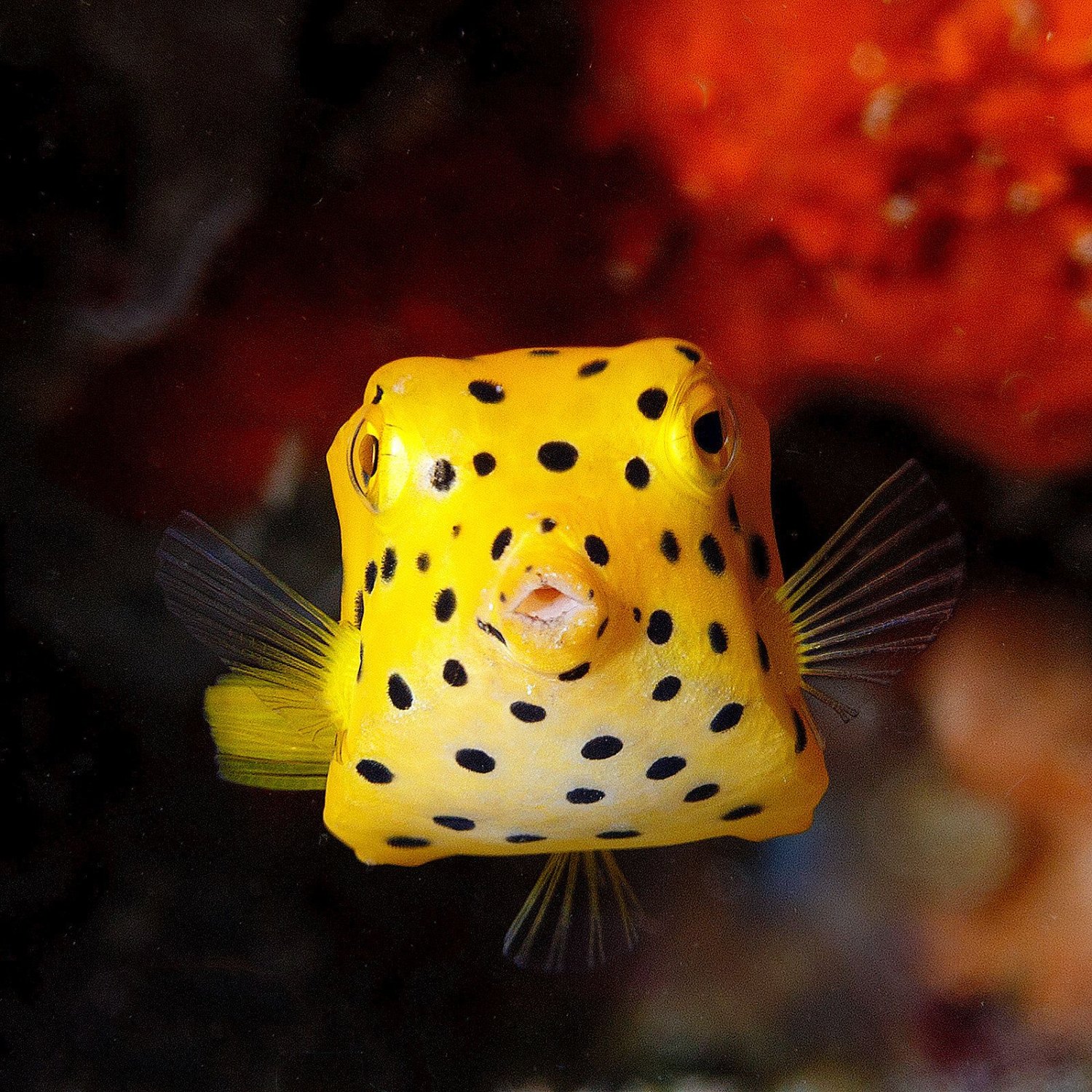
Boxfish
Varies depending on species, usually between 4 to 18 inches (10 to 45 cm)
The Boxfish, from the Ostraciidae family, is a box-like fish found in the ocean depths up to 65 feet. Its length may vary between 4 to 18 inches, making it a popular aquarium choice. With its unique shape and vibrant colors, the Boxfish is a fascinating addition to any underwater ecosystem.
Animal Details Summary:
Common Name: Boxfish
Kingdom: Animalia
Habitat: Coral reefs
The Fascinating World of Boxfish: An Underwater Marvel
The ocean is a vast and mysterious place, home to countless unique and mesmerizing creatures. One such creature is the boxfish, an extraordinary fish known for its remarkable appearance and behavior. In this article, we will dive deep into the world of boxfish, exploring its scientific background, habitat, behaviors, and more.The boxfish, also known as Ostraciidae in the scientific community, is a member of the Actinopterygii class, within the Tetraodontiformes order Boxfish. This family of fish is native to tropical and subtropical regions, inhabiting coral reefs and ocean depths of up to 65 feet (20 meters). They are found in various countries around the world, depending on the species.
The boxfish is a unique creature, with a remarkable appearance that sets it apart from other fish in the ocean. Its body shape is box-like, hence the name, and it comes in a variety of sizes, ranging from 4 to 18 inches (10 to 45 cm) in length. Its most notable feature is its brightly colored exterior, which makes it easily recognizable and adds to its charm.
One of the most intriguing aspects of the boxfish is its feeding method. These fish are omnivorous, meaning they feed on both plants and animals. This makes them a crucial part of the marine ecosystem as they help maintain the balance between various species. They use their small but powerful jaws to crush and eat their food, which includes plankton, crustaceans, and algae Bombardier Beetle.
The boxfish has captured the fascination of marine biologists and nature enthusiasts alike, and it's not difficult to understand why. Let's take a closer look at this underwater marvel and uncover some of its secrets.
The Life and Habitat of the Boxfish
As mentioned earlier, the boxfish is commonly found in tropical and subtropical regions, primarily inhabiting coral reefs. These colorful creatures are often spotted in the Caribbean, Indian Ocean, and western Pacific Ocean. They prefer warmer waters, making them a common sight in the Great Barrier Reef.Boxfish spend most of their time near the ocean floor, where they can easily find food and shelter. Some species are known to inhabit deeper waters, up to 65 feet (20 meters), while others prefer shallow reefs closer to the surface. They are quite territorial and often found near their preferred hiding spots, which include caves and crevices.
Their box-like body shape serves as an advantage in their habitat. The hard, bony plates that cover their body protect them from predators like octopus and larger fish. They are also excellent at blending into their surroundings, thanks to their bright coloration, making them difficult to spot by their enemies.
In addition to their natural habitat, the boxfish also thrives in man-made structures such as artificial reefs and shipwrecks. This is due to the abundance of food and shelter available in these environments. However, like many other marine creatures, the boxfish is also facing threats from human activities such as pollution and overfishing, which are slowly degrading their habitats.
The Bizarre Body and Coloration of the Boxfish
One of the most distinctive features of the boxfish is its box-like body shape. It's made up of bony plates that are fused together, providing protection to the fish while still allowing them to move and swim freely. These plates also give the fish its unique angular appearance, making them stand out in the ocean.The bony plates of the boxfish are covered in a thin layer of skin, which can be smooth or rough depending on the species. This skin is often brightly colored, varying from vibrant yellows and oranges to dark blues and greens. The purpose of this colorful exterior is still unknown, but some theories suggest that it may serve as a warning to predators or help with communication among boxfish.
Another interesting aspect of the boxfish's appearance is its small and retractable dorsal, anal, and pelvic fins. These fins are used for stability, allowing the fish to maneuver and swim with ease. When threatened, the boxfish can also use these fins to hide in crevices or wedge themselves into small spaces, making it difficult for predators to reach them.
The Behavior and Reproduction of the Boxfish
The behavior of the boxfish is as peculiar as its appearance. They are generally solitary creatures, only coming together during the spawning season. During this time, the male and female boxfish perform an elaborate courtship dance, which involves circling and nipping at each other, ultimately leading to the release of eggs and sperm.Interestingly, boxfish are also known for their unique defense mechanism. Apart from their hard exterior, they have the ability to secrete a toxic substance called ostracitoxin. This toxin is lethal to other fish, but not harmful to humans unless ingested. It acts as a deterrent against predators, giving the boxfish a chance to escape unscathed.
When it comes to reproduction, boxfish are oviparous, meaning they lay eggs. The female boxfish will lay hundreds of sticky eggs inside a chosen hiding spot, such as a crevice or cave. The male will then guard and protect the eggs until they hatch after a week or so. The baby boxfish will hatch as tiny, transparent larvae and gradually develop their hard, bony plates and colorful exterior as they grow.
The Importance of Boxfish in the Coral Reef Ecosystem
Boxfish play a crucial role in the health of coral reefs and the ocean ecosystem as a whole. As omnivorous creatures, they help regulate the population of certain species, ensuring that no one species overtakes the others. They also contribute to the health of coral reefs by feeding on algae that can harm or kill the corals.Furthermore, boxfish also have a symbiotic relationship with cleaner wrasse, a small fish that helps keep the boxfish clean by getting rid of parasites and dead skin. This behavior helps maintain the boxfish's health, making them vital to the coral reef ecosystem.
The Misconceptions about Boxfish and Their Conservation
Despite their critical role in the marine ecosystem, boxfish are often misunderstood and vilified by humans. Due to their box-like shape, they have been mistakenly referred to as the "fish of death," leading many to fear and harm them. However, this is far from the truth as boxfish are generally docile and pose no significant threat to humans.Another misconception about boxfish is that they make good pets. While they may be attractive and appealing to some, they do not thrive well in captivity. They require specialized care and an oceanic environment to survive, which is often impossible to replicate in a home aquarium. Keeping boxfish as pets not only harms the fish but also contributes to their dwindling populations in the wild.
To ensure the survival of boxfish and the marine ecosystem as a whole, it is crucial to spread awareness about their importance and educate people about responsible and ethical interactions with these creatures.
The Future of Boxfish in the Ocean
Sadly, like many other marine species, boxfish are facing threats from human activities and climate change. Pollution, overfishing, and destruction of their natural habitats are a significant cause of concern for the survival of these remarkable fish. It's essential to take steps to protect and preserve their habitats and prevent further degradation of the ocean environment.One positive step is that boxfish have been successfully bred in captivity in some aquariums, reducing the pressure on wild populations. However, it is crucial to ensure that any breeding programs are sustainable and do not harm the natural behavior or populations of these fish.
In conclusion, the boxfish is a fascinating and vital part of our ocean ecosystem. Its unique appearance and behaviors make it a remarkable creature, worthy of admiration and protection. By spreading awareness and taking action to protect their habitats, we can ensure the survival of boxfish and other marine species for generations to come.

Boxfish
Animal Details Boxfish - Scientific Name: Ostraciidae
- Category: Animals B
- Scientific Name: Ostraciidae
- Common Name: Boxfish
- Kingdom: Animalia
- Phylum: Chordata
- Class: Actinopterygii
- Order: Tetraodontiformes
- Family: Ostraciidae
- Habitat: Coral reefs
- Feeding Method: Omnivorous
- Geographical Distribution: Tropical and subtropical regions
- Country of Origin: Variable, depending on species
- Location: Ocean depths up to 65 feet (20 meters)
- Animal Coloration: Brightly colored
- Body Shape: Box-like
- Length: Varies depending on species, usually between 4 to 18 inches (10 to 45 cm)
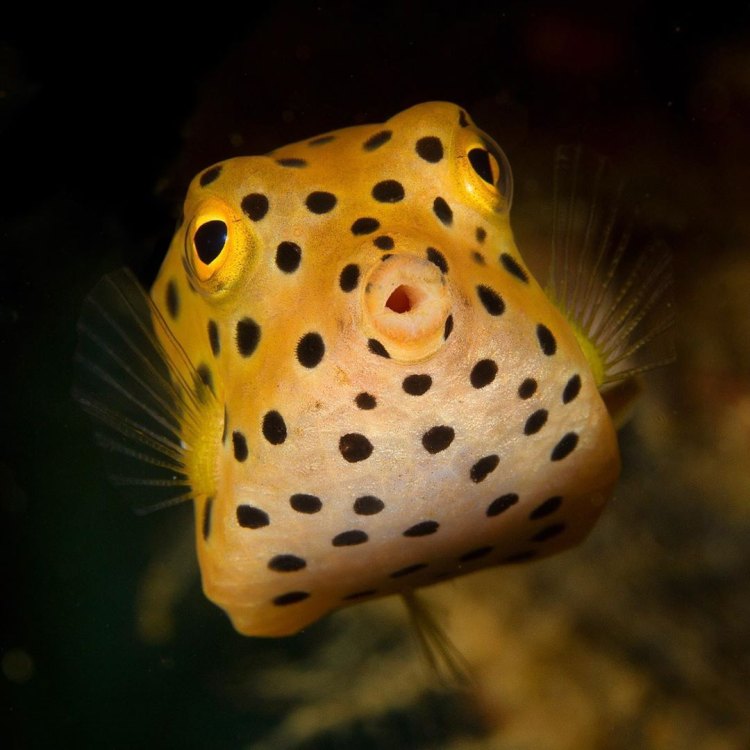
Boxfish
- Adult Size: Varies depending on species, usually between 4 to 18 inches (10 to 45 cm)
- Average Lifespan: 10 to 15 years
- Reproduction: Sexual
- Reproductive Behavior: Eggs are laid and fertilized externally
- Sound or Call: No distinct sound or call
- Migration Pattern: Non-migratory
- Social Groups: Usually solitary
- Behavior: Slow-moving and peaceful
- Threats: Coral reef destruction, overfishing, and pollution
- Conservation Status: Varies depending on species, some are listed as vulnerable or endangered
- Impact on Ecosystem: Play an important role in maintaining the health and balance of coral reef ecosystems
- Human Use: Popular in the aquarium trade
- Distinctive Features: Box-like body shape and tough, bony plates covering their bodies
- Interesting Facts: 1. Boxfish have the ability to release toxins when stressed or threatened, which can be harmful to other fish. 2. They have fused teeth that form a beak-like structure for feeding on coral polyps and algae. 3. Some species of boxfish can change color, which they use for communication and camouflage.
- Predator: Varies depending on species, but some common predators include large fish and sharks
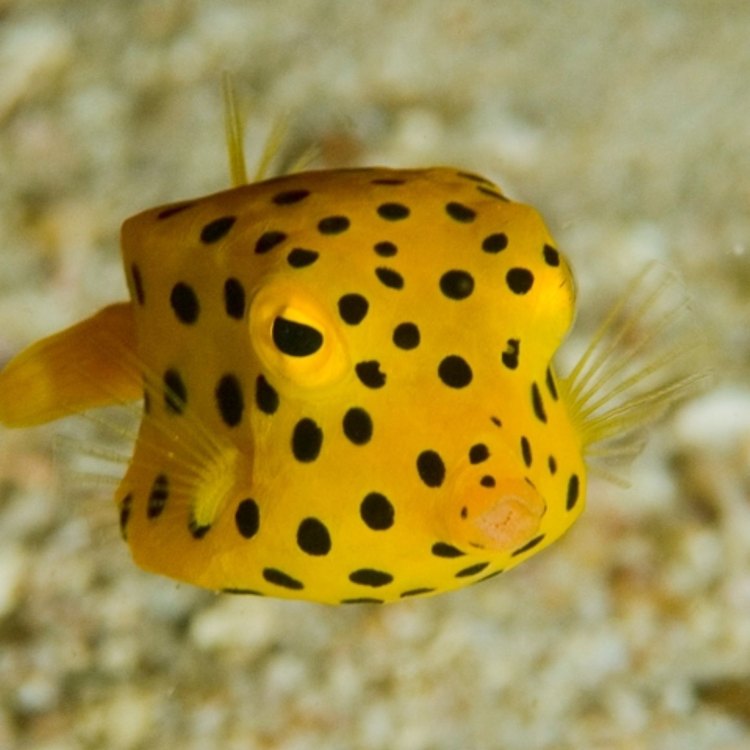
Ostraciidae
The Mysterious and Unique World of Boxfish
Imagine swimming in the crystal clear waters of a tropical coral reef, surrounded by vibrant colors and a variety of marine life. Among the schools of colorful fish and intricate coral formations, you may come across a curious creature known as the boxfish.Boxfish, also known as trunkfish or cowfish, are a group of fish belonging to the family Ostraciidae. They are found in tropical and subtropical waters around the world and are known for their distinct box-like body shape and tough, bony plates covering their bodies PeaceOfAnimals.Com. In this article, we'll delve into the fascinating world of boxfish and uncover their unique features, behavior, and impact on the ecosystem.
The Basics: Size, Lifespan, and Reproduction
Boxfish come in a variety of sizes, with the average adult size ranging from 4 to 18 inches (10 to 45 cm) depending on the species. Some of the largest species can reach up to 2 feet (60 cm) in length. Despite their size, boxfish have a relatively long lifespan, with an average of 10 to 15 years in the wild.As for reproduction, boxfish are sexual creatures, with males and females coming together to mate. However, their reproductive behavior is unique in that they lay their eggs and fertilize them externally. The female will release a large number of eggs into the water, and the male will then release his sperm to fertilize them. After hatching, the larvae will spend a few weeks drifting in the ocean currents before settling in a suitable location to grow and mature.
Behavior and Social Groups
Boxfish are generally slow-moving and peaceful creatures, often found slowly cruising around the reef or hiding within the crevices of coral formations Blanket Octopus. They are usually solitary and do not form large social groups. However, during mating season, they may come together in pairs.One of the most unique and intriguing behaviors of boxfish is their ability to release toxins when stressed or threatened. These toxins, known as ostracitoxin, can be harmful to other fish in the vicinity and serve as a defense mechanism against predators. This is why boxfish are often able to roam around with little fear of being caught by other fish.
Threats and Conservation Status
Like many marine species, boxfish face numerous threats in their natural habitats. One of the biggest threats is coral reef destruction, which is caused by factors such as climate change, ocean acidification, and destructive fishing practices. Boxfish are also at risk of overfishing for the aquarium trade, as they are popular and prized for their unique appearance.As a result, some species of boxfish, such as the spotted boxfish and the yellow boxfish, are listed as vulnerable or endangered on the IUCN Red List. The conservation status of other species varies, but all of them are facing threats in the wild.
The Role of Boxfish in Ecosystems
Boxfish may not be the most visually striking creatures in the ocean, but they play a crucial role in maintaining the health and balance of coral reef ecosystems. They feed on coral polyps and algae, which helps to keep these populations in check and prevent overgrowth.In addition, their tough, bony plates act as natural armor, protecting them from predator attacks and allowing them to thrive in their environment. As mentioned earlier, their ability to release toxins also serves as a defense mechanism, helping to keep the coral reef community in balance.
Human Use and Distinctive Features
Given their peculiar appearance, it's no surprise that boxfish are a popular choice in the aquarium trade. Their unique box-like body and gentle, slow-moving behavior make them an interesting addition to any tank.One of the most distinctive features of boxfish is their fused teeth, which form a beak-like structure. This specialized mouth is adapted for feeding on hard-bodied creatures such as coral polyps and algae, making them valuable herbivores in their ecosystem.
However, it's important to note that boxfish require specific care and a suitable environment to survive in captivity. Without proper care and attention, they may succumb to stress-related illnesses and have a shorter lifespan compared to their wild counterparts.
Interesting Facts About Boxfish
1. Boxfish have a unique ability to change color, which they use for communication and camouflage. They have specialized pigment cells called chromatophores that allow them to change color almost instantly, helping them blend in with their surroundings or communicate with other fish.2. Some species of boxfish, such as the longhorn cowfish, are known for their distinctive horns or "horns." These are actually modified fin rays that they use to shovel through the sand in search of food.
3. Despite looking like armored tanks, boxfish are actually quite agile and can swim relatively fast when needed. They often use their pectoral fins to propel themselves through the water.
Predators of Boxfish
As with any marine species, boxfish also have their fair share of predators. Some of their common predators include large fish such as groupers and snappers, as well as sharks and other marine predators. However, their tough, bony plates and ability to release toxins serve as effective defense mechanisms against these predators.In Conclusion
Boxfish may not be the most well-known or glamorous creatures in the ocean, but they have a unique and mysterious world that is worth exploring. With their box-like body, fused teeth, and ability to release toxins, they have captured the curiosity and fascination of many. However, as with all marine animals, it's crucial to protect and conserve boxfish and their habitats so that future generations can continue to marvel at their distinctive features and important role in maintaining the health of coral reef ecosystems.
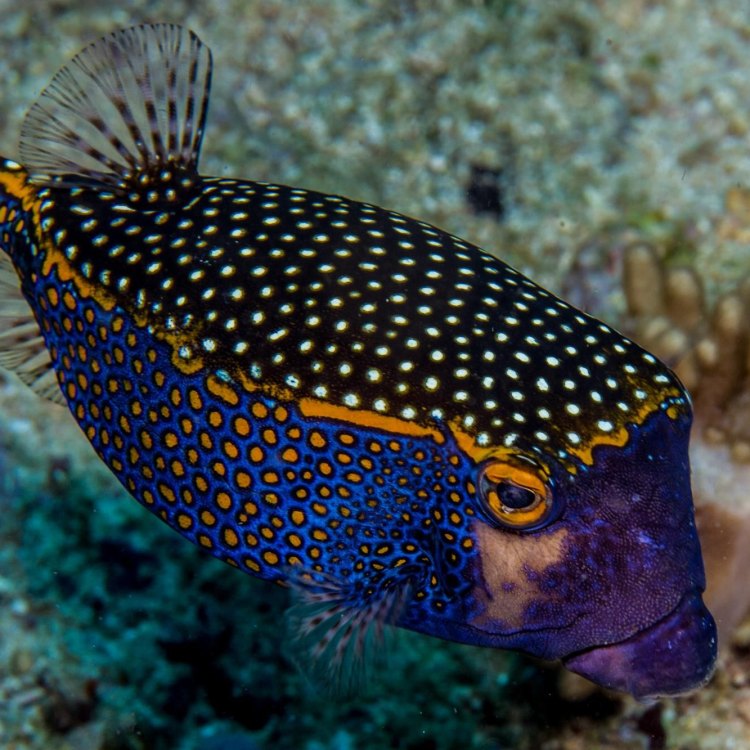
The Fascinating World of Boxfish: An Underwater Marvel
Disclaimer: The content provided is for informational purposes only. We cannot guarantee the accuracy of the information on this page 100%. All information provided here may change without prior notice.









